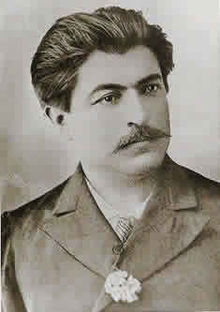Mangal Pandey, famous Indian freedom fighter,. Image via Parda Phash
In our neck of the woods, Movember has become a bit of a little competition. Which Persian can grow the biggest mustache.
I'm sadly - or rather not so sadly - falling behind (I guess that's good for me though, since Persians no longer hold the mustachioed woman in high regards anymore)
You thought I was joking about Qajar women with mustaches? Nope. Via
Now, being that mustaches were so prolific in our region of topic, I've decided to take the opportunity to get in the spirit of the season, spread the Movember message, and make this a blog instead of a picture post.
Here are some famous mustaches from the latter part of the 19th century.
Abdulhamid II (picture via)
Abdulhamid II was the 34th Sultan of the Ottoman Empire from August 31st, 1876 to April 27th, 1909 when he was finally deposed indirectly by the Young Turk Revolution. He's best known as the last Ottoman Sultan to really effectively exert his control over the Empire, as well as creating a modern system of record-keeping of his personnel, beginning the Hejaz Railway, and bringing the Ottoman Empire into its modernity.More about Abdulhamid II can be read here
Wajid Ali Shah (picture via)
Wajid Ali Shah was the last Nawab of Oudh (Now part of modern day Uttar Pradesh). His reign began in February of 1847 and ended with the annexation of his kindgom to the British on February 7th of 1856, only a few days shy of his 9th anniversary of his coronation.Wajid Ali Shah was a poet, a playwright, a dancer, and a general patron of the arts. It was written of him once
"He is entirely taken up in the pursuit of his personal gratifications. He has no desire to be thought to take any interest whatever in public affairs and is altogether regardless of the duties and responsibilities of his high office. He lives exclusively in the society of fiddlers, eunuchs and women: he has done so since his childhood, and is likely to do so till his last."Indeed, even after his exile to Calcutta he continued to live lavishly on the pension provided to him by the British in exchange for his peaceful annexation of his kingdom. Before long there was a "Second Lucknow" in his home away from home.
Among the arts Wajid Ali Shah is known for is his beautiful poetry, which you can listen to a recording of here performed by Pt Bhimsen Joshi. Not only was he a poet, but he is also responsible for preserving the art of kathak and bringing it back to it's rightful glory in his court and his exiled Matiya Burj.
More about the Nawab can be found here and a wonderfully done portrayal of him in his last days as Nawab done by Amjad Khan for the film "Shatranj Ke Khilari" can be found here. The conversation with his crying attendant contains a beautiful quote by the Nawab which speaks very clearly of his character: "Only love and poetry can bring tears to a man's eyes."
 |
| More about Nasser al-Din Shah Qajar here |
Nasser al-Din Shah Qajar (picture via)
Nasser al-Din Shah ruled Iran (then Persia) from September of 1848 until his assassination on the First of May, 1896. Despite his assassination, he was the third longest reigning Shah of Iran.Like Wajid Ali Shah, Nasser al-Din Shah was also a poet with a love of women and the arts. Nasser al-Din's love of arts manifested not only in his poetry, but his paintings, sketches, and his adoption and embrace of photography.
His love of Western culture led him to introduce the telegraph, as well as the concept of post service, to Persia. In addition, he curbed the secular power of the clergy, created the first modern school, built up roads, and launched Iran's first newspaper.
Because he was the first Iranian to be photographed (this may or may not be true, but for facilities sake, I'll assume it is) Persia embraced photography in a way they otherwise might not have. The Shah's love of photography and women allowed the photographer Antoin Sevruguin to establish a career that left behind a great legacy of documenting the lives, fashions, and culture of Iran and Iranians, especially the women who under more religious constraints might have been ignored. While he was, no doubt, influenced by the Orientalist movement and consequent demand of those types of photos, Sevruguin himself loved capturing the real Persia of the time.
 |
| Nasser al-Din Shah Qajar being attended by his barbers and having his mustache dyed. Photo via |
So because of that, even though often times amongst Iranians nowadays the Qajar Era is considered one of the worst in our history, I have to give the man credit for making documenting such a pivotal time in our history possible. As a historian, I really should be despising the Pahlavis, who actively sought out and destroyed many of Antoin Sevruguin's photos and negatives because they didn't think they represented the "Modern" Iran that they wanted to portray.
Yep.
 |
| Antoin Sevruguin via |
So back to Movember.
My fiance, on Halloween night, decided to finally shave off all the "excess" hair from his beard and mustache that he started growing three weeks ago. I can't tell if he was growing the mustache for Movember itself, if he grew it because he always wanted a Qajar-style handlebar mustache, if he's growing it because of Steampunk and so wanted it for the "authenticity" aspect, or a combination of some of those reasons.
Anyhow, this is his baby-'stache so far.
The stubble's coming back up, so maybe in three more weeks the mustache will be big enough to get an impressive curl once the wax is applied.
We shall see.



.jpg)



No comments:
Post a Comment